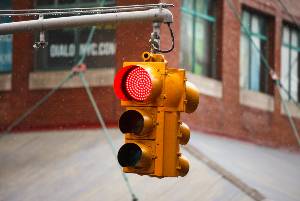 Red-light crashes are incredibly dangerous because drivers who have the right of way expect other drivers to stop at a red light. When they do not stop, they can hit unsuspecting motorists and cause them to suffer severe or even life-threatening injuries.
Red-light crashes are incredibly dangerous because drivers who have the right of way expect other drivers to stop at a red light. When they do not stop, they can hit unsuspecting motorists and cause them to suffer severe or even life-threatening injuries.
Usually, the driver who runs the red light is found liable for damages from the crash. However, fault can be complicated because these crashes happen in intersections where there is a lot of activity. Sometimes both parties or multiple parties share liability for a red-light crash.
Below, the experienced attorneys at Schmidt Kramer discuss red-light crashes, including Pennsylvania laws on red lights and how they may impact liability for a crash. If you were injured by a red-light runner, give us a call today to discuss legal options.
General Rules on Liability for Red-Light Accidents
If a driver has a red light and he or she is involved in a crash, he or she is likely to blame. You are required to come to a complete stop at a solid red light.
You can turn right on a red light if there is no sign posted that advises drivers that they cannot turn on a red light. However, you are required to come to a complete stop, check for traffic and you can only proceed if it is safe to do so. If the light is a red arrow, you cannot turn on it.
If you turn when it is not safe to do so, or when you are prohibited to do so because of a sign or red arrow, and a crash happens, you are likely to be found at fault.
Pennsylvania also has a law called the Ride on Red law that took effect in late 2016. Under this law, drivers who are stuck at an unresponsive red light are allowed to proceed as if the red light is a stop sign. They must come to a complete stop, and if it is safe to proceed, they can do so.
It is important to note this law is only meant to apply when a traffic light is broken or unresponsive. Drivers still have a duty of care to prevent a crash. If you do not use caution, and a crash occurs, you may be found at fault for the accident.
What if the Light is Flashing Red?
Unfortunately, many drivers are confused about what they are supposed to do at a flashing red light. You are supposed to treat this as a four-way stop. That means you must come to a complete stop. If you arrive first, you have the right of way.
If you violate another driver’s right of way, you are likely to blame for the crash.
When Could the Driver Who Did Not Run the Red Light be at Fault?
Sometimes a driver besides the one who ran the red light could be found liable for damages. For example, if a driver turned on a red light but was hit by a driver who changed lanes, the other driver may be at least partially at fault.
Even if you run a red light, if the oncoming cars have enough time to stop before a crash, the oncoming drivers may bear partial fault for the crash. However, if the red-light-runner moved into the intersection long after the light changed, the red-light-runner is likely to be found fully at fault.
Risk Factors and Dangers of Red-Light Crashes
There are various risk factors for red-light crashes, including:
- Impairment with drugs or alcohol
- Age of the driver, as younger drivers are more likely to run red lights
- Inexperienced drivers
- Drivers who are in a rush, such as drivers who are late to work or an appointment
- Aggressive drivers
- Speeding drivers
- Poor visibility due to weather or other conditions
These crashes are extremely dangerous and often result in devastating injuries. Typically, you are moving through an intersection at a higher-than-normal rate of speed. This can cause a T-bone collision with another vehicle and the sides of vehicles are not built to withstand these impacts.
Seeking Compensation After a Red-Light Crash
Fault is not an issue in a claim for personal injury protection (PIP) benefits. However, if your damages exceed the value of your PIP policy, you may need to seek compensation from the at-fault driver’s liability insurance.
In a liability insurance claim, your Harrisburg-based auto accident attorney would need to establish another driver was at fault. He or she could use various pieces of evidence to do this, including:
- Analysis of the damage to your vehicle
- Traffic camera footage
- Security camera footage
- Dash cam footage
- Police report
- Witness testimony
- Pictures from the scene
- And more
Have Questions After a Crash Injury? Give Us a Call
For decades, the attorneys at Schmidt Kramer have been helping crash victims recover compensation for damages. We have detailed knowledge of traffic laws and the process of recovering insurance compensation.
If you have any questions about your legal options, you can discuss the situation with a licensed attorney in a free legal consultation. There is no obligation to hire our firm after meeting with us.
Contact Schmidt Kramer to learn more. (717) 727-2550

